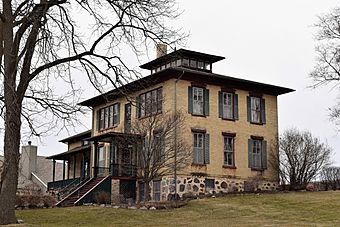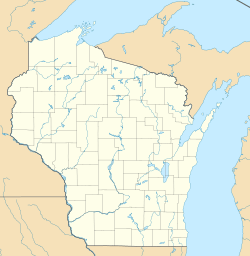Ferdinand C. Hartwig House facts for kids
Quick facts for kids |
|
|
Ferdinand C. Hartwig House
|
|
 |
|
| Location | 908 Country Lane Watertown, Wisconsin |
|---|---|
| Built | 1864 |
| Architectural style | Italianate |
| NRHP reference No. | 82000662 |
| Added to NRHP | June 17, 1982 |
The Ferdinand C. Hartwig House is a cool old building in Watertown, Wisconsin. It's located at 908 Country Lane. This historic house was added to the National Register of Historic Places on June 17, 1982. This means it's a special place worth protecting because of its history.
Contents
The House's Story
This house was built in 1864 by Ferdinand Hartwig. He was an immigrant from Prussia, which is a historical region in Europe. Later, the house was owned by Kirby and Judith Brant. Since 1998, Jerold and Jill LaPinske have been the owners.
What the House Looks Like
The Hartwig House sits on a small hill. It's a two-story building made of cream-colored brick. It's built in the Italianate style. This style was popular in the mid-1800s. It often features wide eaves and decorative windows.
The house has a special small tower on the roof called a cupola. It also has wide eaves that hang over the walls. The windows have flat tops, and some have decorative peaked tops. There's a dormer window on the hip roof. The front door has windows on the sides and above it. A porch with a flat roof and square columns protects the entrance. There's another porch on a different part of the house.
The foundation of the house is made of fieldstone. This is a type of stone found in fields. The house is in great shape today. Some of the original windows have been changed over time. An addition was also built onto the house at some point.
The Farm Around the House
Until the 1950s, this house was part of a large farm. It had a barn and other farm buildings around it. Over the years, the farmland has been divided into smaller lots. Now, other homes and buildings stand where the farm used to be.
Why the House is Important
The Ferdinand Hartwig House is important for two main reasons. It shows a good example of the Italianate style in Watertown. It also tells us about Ferdinand Hartwig's important work with dairy cows.
Italianate Style in Watertown
The Hartwig House is a great example of the Italianate style. This style was common in homes built during the mid-1800s. The house has a cupola with many small windows. It also has wide eaves and decorated window tops. These are all typical features of the Italianate style.
While it's a good example, other Italianate homes in Watertown might be even more fancy. Still, the Hartwig House helps us understand how this style looked in everyday homes.
Ferdinand Hartwig and Dairy Farming
Ferdinand Hartwig built this house in 1864. At that time, it was the center of his big farm. His farm was on the edge of Watertown. He lived in this house until 1921.
Hartwig was a German immigrant. He came to the Watertown area in the 1850s. He bought his farm in 1861 and then built this nice house. He grew a lot of grain crops on his farm. He also raised sheep and cattle.
By 1890, dairy farming was becoming very important in Wisconsin. Hartwig started to focus on breeding Holstein-Friesian dairy cattle. These cows are now the main type of dairy cow in Wisconsin. Hartwig's work helped many dairy farms in the Watertown area get started with these important cows.
A Special Place in History
This house is listed on the National Register of Historic Places. This is because of its architecture and its connection to local history. Ferdinand Hartwig was very important in improving and promoting Holstein cattle. Since Holsteins became the most important dairy cows in Wisconsin, and this house is the only building left that's connected to Hartwig, it's a very special historical site.



